
































When I tell people I’m a journalist, it’s usually met with one of three reactions. There’s the individual who proceeds to explain every reason they hate the media and journalism. There’s the person who immediately asks what I think about the newest heartbreaking news stories. And then there are the people who ask what I want to do in journalism, and when I say I want to work at a local, independent news outlet, they respond, “Good luck. That’s a dying field.”
I disagree. Local news is everywhere — you just need to be open to looking for it. And it can appear different than you’d expect, even in an area like Columbia that is saturated with news outlets and journalists.
Over the past five years that I’ve lived in Columbia, I’ve noticed that the city needs news, just like news needs the city. The reader service coverage produced by Columbia’s news outlets can connect people with the resources they need to live everyday life. In this issue of Vox, our stories explore the numbers that makes Marching Mizzou tick (p. 5) and accessible transportation options through the Cars 4 Missouri nonprofit organization (p. 10). It also dives into what Boone County health care professionals are doing to mitigate maternal mortality in Missouri


and where Missourians can access this care (p. 22) showing Vox’s ability to cover the heavier topics as well as lighthearted ones.
And the large media presence in this city has also afforded it opportunities that wouldn’t exist otherwise. Staffers at KCOU 88.1 FM, the University of Missouri’s student-operated radio station, got a message from 2000’s poppunk band The All-American Rejects in May that led to an iconic East Campus concert. Vox chronicles how Columbia became another viral stop on the band’s nationwide, house-party tour (p. 14).
By holding up a mirror and reflecting what we see, the stories in this issue highlight aspects of the community that make it uniquely itself. Columbia wouldn’t be Columbia without the news outlets that represent it — just like the work we do couldn’t be done without the community of people who shape it.
Now more than ever, local news outlets are fighting for the right to exist in the communities they serve, but there are so many examples of their success. So, the next time you hear someone talk about journalism, know that the doom and gloom is only half the picture. Think of the people behind the work. Your community wouldn’t be the same without them.

Cayli Yanagida Editor-in-Chief
This summer, I was interning at Missouri Business Alert while still dreaming of being a music journalist. So, when the Vox editors asked if I’d want to write a story chronicling how KCOU set up the May 18 secret The All-American Rejects show on East Campus, my answer was obvious. I interviewed the many people who played a vital role in organizing the show — while also recalling my own experience with it as a KCOU staffer. The result is a month-by-month, then hour-by-hour account (p.14). It’s a behind-thescenes peek for The All-American Rejects fans who haven’t had the chance to make it to one of the band’s secret shows or for those who are just curious about how it all came to be.—Charlie Warner
Corrections: There were several errors in the September/October issue. The correct URL for Mid-Missouri PrideFest is midmopride.org. The Crafternoon event on Oct. 14 took place 2-4 p.m. The story about the Congress of Racial Equality and desegregation should have stated that Clark’s Soda Luncheonette was located in what’s now Simmons Bank on Broadway.
EDITOR-IN-CHIEF CAYLI YANAGIDA
MANAGING EDITORS AVERI NORRIS, ALLY SCHNIEPP
DEPUTY EDITOR AUSTIN GARZA
DIGITAL MANAGING EDITOR BRIANNA DAVIS
AUDIENCE ENGAGEMENT EDITOR CLAIRE WILLIAMS
ART DIRECTORS RACHEL GOODBEE, VALERIE TISCARENO
PHOTO DIRECTOR AVA KITZI
MULTIMEDIA EDITOR ARABELLA COSGROVE
PODCAST PRODUCER KIANA FERNANDES
ASSOCIATE EDITORS RACHEL GOODBEE, KATIE GRAWITCH, JAZMYNE MARTINEZ, BROOKE RILEY, CHARLIE WARNER, EMMA ZAWACKI
STAFF WRITERS DAVID ALDRICH, SOPHIE AYERS, ALLI BEALMER, GRACE DEEN, ALEX GOLDSTEIN, AUGUSTUS HENDERSON, MARISSA HORN, JASMINE JACKSON, SOPHIE LINDBERG, MATTHEW OSTHOFF, NEALY SIMMS, ACIYA EL TAJOURY, JACKSON WEST, TYLER WHITE
SOCIAL & AUDIENCE EMMA CLARK, ABIGAIL DURKIN, CHLOE IRELAND-KILLDAY, NEALY SIMMS, PARIS SPENCER
DIGITAL PRODUCERS ALLI BEALMER, LUCIANA
DE ANDA, JAKE MARSZEWSKI, CLAIRE POWELL
DESIGN ASSISTANT LAUREN JOHNSON
CONTRIBUTING WRITERS MERCY AUSTIN, EMILY EARLY, EMMA HARPER, GRACE ROMINE
CONTRIBUTING PRODUCER ETHAN DAVIS
EDITORIAL DIRECTOR HEATHER ISHERWOOD
DIGITAL DIRECTOR LAURA HECK
WRITING COACHES CARY LITTLEJOHN, JENNIFER ROWE
FOLLOW US

WANT TO BE IN-THE-KNOW?
Sign up to receive Vox ’s weekly newsletter, the “Vox Insider.” We’ll tell you how to fill up your weekend social calendar and keep ahead of the trends. Sign up at voxmagazine.com.

CALENDAR send to vox@missouri.edu or submit via online form at voxmagazine.com
ADVERTISING 882-5714 | CIRCULATION 882-5700 | EDITORIAL 884-6432
NOVEMBER 2025
VOLUME 27, ISSUE 8 PUBLISHED BY THE COLUMBIA MISSOURIAN LEE HILLS HALL, COLUMBIA MO 65211
Cover design: Valerie Tiscareno
Cover photography: Russ Bray; Adobe Stock
Legacy marches forward
Keep count of Marching Mizzou’s storied history starting in 1885. 08
Welcome, Trader Joe’s
As the Columbia store opens, check out all you need to know about TJ’s.
Vox Picks
Whether you want to smash pumpkins or attend the ballet — here is what Vox is looking forward to in November.
Shifting gears
Anthony Conway has dedicated his life to helping people find reliable transportation. CULTURE
Dramatic opera myths
Bust misconceptions about a centuries-old art form with Landlocked Opera.



A ‘Dirty Little Secret’
Go behind the scenes to learn how KCOU organized a legendary pop-up show for The All-American Rejects.
Missing mothers
Missouri programs aim to reduce the rate of pregnancy-related deaths.



Don’t bis-skip these spots
Columbia’s selection of distinctive biscuits and combinations won’t disappoint.
Unbelievea-bowl noodles
Cozy up or expand your palate with one of six flavorful Asian noodle dishes.
Bakin’ in the dough
Discover how a city program helped Elijah Sparks find a calling in baking.
Have a blast in the past
Missouri’s rich history is on display at these historical sites and museums.





From Faurot Field to London, here’s a by-the-numbers guide to the music of Marching Mizzou.
BY TYLER WHITE
If you’re walking past the Hearnes Center in the afternoon, there’s a good chance you’ll see flying batons and uniformed marchers. Maybe you’ll hear thunderous percussion and roaring brass, too. These are the sights and sounds of Marching Mizzou gearing up for its next show.
Week in and week out, members of the University of Missouri’s marching band are working to hone their craft and provide the best performances. Hours of dedication and practice go into perfecting the details, from the distance between each step to the time it takes to switch formations on the field.
The band is one of the core identities of Mizzou and Amy M. Knopps, director of Marching Mizzou, says it is the “soundtrack to the university.” Beyond the music and the performance, Knopps says she wants the band to be a family for its members, and that shines through in their dedication and support for each other. “We can play ‘Hey Baby!’ on a game day, but what matters the most to me is they’re doing that beside the very best friends that they’re going to have in their life,” she says.
To better understand what goes on behind the scenes, let’s fall into formation and high-step our way through the numbers that give Marching Mizzou the legacy it carries today.
$125
The UM System Board of Curators provided a $125 grant to form the band in 1885. At that time, there were only 12 members.
140
Knopps says labeling each year’s band with a number helps the students understand their contributions to the group’s legacy. Hadley Haux, director of the Marching Mizzou Alumni Band, recalls the significance of being a part of Marching Mizzou in the 1980s. At his first music rehearsal, the band played the university’s fight song and “Missouri Fanfare” on stage at Jesse Hall. “It was just almost overwhelming,” Haux says. “I’m like, man, I’m in the right place.”
61,620
During each home football game at Memorial Stadium, Marching Mizzou performs for almost 62,000 seats. That’s the capacity after the south end zone additions in 2019. The band prepares a unique halftime performance for each game, learning three songs of varying styles and genres with new formations to keep it fresh for fans.
350
A far cry from the first dozen marchers, this year’s Marching Mizzou includes hundreds. “With 350 members, you know so many people across campus,” says Maddie Balsman, a fourthyear business student and a drum major in Marching Mizzou. “And that kind of connects you to everyone.”
The Mizzou fight songs “Every True Son” and “Fight Tiger” are played third and fourth in the pregame performance. Over the decades, the fight songs have gained the nicknames 3 and 4.
Marching band members learn how to walk using a rolled, heel-first stepping pattern, where each step is precisely 22.5 inches. This keeps movement crisp and allows directors to craft new formations that are consistent and geometrically precise. They learn how to traverse the football field in these formations, crossing 5 yards in exactly eight steps. “There’s a lot of math that goes into marching band,” says Maggie Howell, a drum major.
All members of Marching Mizzou enroll in a one-credit hour course, MUS_ENS 1841, section 12. On the Monday prior to a Saturday performance, band members complete memory exams related to the music they are required to perform on game day. These memorization exams cover each aspect of the band, including choreography, performance and photography for media.
Most members are studying one of the other 75-plus majors across campus. Only 16% of band members are actually music majors at Mizzou. “It’s this very beautiful marriage of everyone with different backgrounds and environments,” says drum major and fourth-year music education student Ava Lairmore. “But at the end of the day, we all come together and create music because we love music.”
Each season, Marching Mizzou students learn about 45 new songs for their performances.

Ba nd 115 performed at President George W. Bush’s 2001 presidential inauguration ceremony in Washington, D.C.
Band 137 turkey-trotted at the Macy’s 96th annual Thanksgiving Day Parade in 2022.
The smallest section of Band 140 is the feature twirlers with just three members.

8
From musicianship to health and wellness, there are eight committees within the band covering the individuality and the identity of Marching Mizzou. “We’re more than just the band kids,” Lairmore says. “We’re all individuals who care about our craft.”
One of Marching Mizzou’s signature, show-stopping moments during halftime performances is called Flip Tigers, where the band members take only eight counts of music to transition formations from spelling MIZZOU to spelling out TIGERS. Charles Emmons, the band director at the time, and his assistant, John Christie, came up with the move, which debuted at the 1960 Orange Bowl game against the Georgia Bulldogs.
Women were first allowed to join Marching Mizzou in 1958, and the Golden Girls became the official dance group of the university in 1965 after Emmons watched a twirler audition — wearing a sparkly silver bodysuit — and got an idea. Patty Gramm Kespohl was a twirler on the 1965 squad and later became the Golden Girls coach for over 30 years. “He said, ‘I’d like to see that in gold!’” she told the Missouri Sports Hall of Fame. That’s how the Golden Girls sashayed onto the scene.
2
Outside of football season, two Mini Mizzou band groups entertain crowds at Mizzou basketball and volleyball games and the drumline occasionally performs during halftime at soccer games. Band members also travel nationally and internationally for events and special performances.
4,267.9 miles
Thousands of miles separate Columbia Regional Airport and London Heathrow Airport. Fifty years ago, Marching Mizzou made history as the first American entertainment unit to perform at an English sporting event at Wembley Stadium. Marching Mizzou will return to England in 2026 for London Band Week, an invitation-only international musical event. Making — and repeating — history is part of Marching Mizzou’s legacy. “There have been so many traditions that have built up since that,” Howell says. “I’m just really happy that I get to carry on.”
6-8 hours
The band members practice many hours a week. This time — along with the studying, homework and exams — is spent focusing on perfecting the performance by honing in on every detail, including the formations, the songs and the showmanship.
Marching Mizzou’s Band 66 forms an M on Faurot Field during the 195960 season. That same season, the band debuted its signature Flip Tigers formation.
The next time you walk by the Hearnes Center and hear a musical beat, remember there are 140 years of history behind every note.
Dig into the fan groups, hand-drawn signs and hall-of-fame products that fuel Trader Joe’s popularity.
BY GRACE ROMINE
I’m trying to look for a place to sit that isn’t covered in sawdust,” says Pamela Volk in between spelling her name and reciting her title over an afternoon phone call.
It was Oct. 1, and Volk was inside Columbia’s former Macy’s — a store that closed nearly a decade ago. About four weeks earlier, she moved to Columbia from Ballwin to “captain” the new Trader Joe’s grocery store, which has announced an opening date of Oct. 30. Previously, Volk led the Creve Coeur location. While she says her role will be similar, it has been a new experience building a store “from scratch.”
With the opening date now set, Vox sorted through some things to know about Trader Joe’s — whether you’re a frequent shopper with a collection of canvas TJ’s tote bags or a Trader Joe’s newbie wondering what all the fuss is about.
The Trader Joe’s label
Almost every product in the store is under the Trader Joe’s label, including basics such as milk and eggs, as well as variations of brand-name favorites and specialty items. You might not see some products on every visit because they are seasonal or they’ve been moved out to make space for new items introduced every week, Volk says.
Aldi and Trader Joe’s
Trader Joe’s is not related to the Aldi that Columbia shoppers would know.
Aldi was started in Germany by Anna Albrecht. After her sons, Karl and Theo, took over the company, they eventually split it into Aldi Süd, which operates U.S. Aldi stores, and Aldi Nord. This is the company that bought Trader Joe’s from founder Joe Coulombe in 1979. Aldi Nord and Trader Joe’s operate independently — though the families who own Trader Joe’s also own part of Aldi Nord.
The first Trader Joe’s opened in Pasadena, California, in 1967. Coulombe drew inspiration for the stores’ nautical theme from a book set in the South Pacific and a visit to Disneyland.
In-store art
The art throughout the store is designed in-house by store crew members — from the large signs that hang above the aisles to the small ones that mark product prices. “Every store’s art team reflects their neighborhood,” Volk says. “That’s why every Trader Joe’s you go into is a little bit different.”
Finding artistic staff is part of the hiring process. Each store’s art team is made up of the same crew members who stock shelves and help customers. Since the Columbia store is being built from the ground up, it’s receiving help from artists established at other Missouri locations.
controversy
Multiple Trader Joe’s stores have unionized, starting in Hadley, Massachusetts, in 2022. Trader Joe’s United, the in dependent union, says the company’s response has been comparable to that of Amazon or Starbucks. In 2024, the National Labor Relations Board filed 21 unfair labor practice complaints against Trader Joe’s in eight states — a decrease from the 70 filed in 2023. No Missouri stores have voted to unionize.
Meanwhile, Joe’s as the second best large employer in the United States in 2025.
It has super fans
April Heywood of Lake of the Ozarks has been shopping at Trader Joe’s for 10 to 15 years, traveling to Kansas City or St. Louis. “Normally, when you go grocery shopping, it feels like a to-do list item,” Heywood says. “Going to Trader Joe’s is more like: ‘Ooh, what am I going to find today?’ It’s like fun shopping.”
Customers can vote for their favorite products, and repeated favorites are inducted into the Trader Joe’s Product Hall of Fame. It currently includes six products: Soy Chorizo, Unexpected Cheddar, Peanut Butter Filled Pretzel Nuggets, Dark Chocolate Peanut Butter Cups, Mandarin Orange Chicken and Chili & Lime Flavored Rolled Corn Tortilla Chips.






Heywood is not alone.
The Trader Joe’s sub-Reddit has over 480,000 “traders” (members) and the “Favorite Trader Joe’s Products” Facebook group has 1.3 million members. Local enthusiasm is high as well. In January, the KOMU Facebook post confirming news of the Columbia store’s location garnered more than 200 comments and 1,600 likes.
For Heywood, it’s because of the products that she can’t get anywhere else, the fun in-store experience and the friendly staff. Trader Joe’s is also known for its customer engagement initiatives, including the Annual Customer Choice Awards, the Fearless Flyer newsletter and collectible, state-specific reusable shopping bags.
Other Missouri locations include Brentwood, Chesterfield, Creve Coeur, Des Peres and Kansas City.
“When you walk into a Columbia, Missouri, Trader Joe’s,” Volk says. “It will feel very different than if you walk into a New York City Trader Joe’s. It will be similar, but different, because we want to fit our community.”








spinning for artists of all levels of experience. The guild will also showcase work from local fiber artists, so you can get your holiday shopping out of the way before it becomes a sticky stitch-uation. The Columbia Weavers and Spinners’ Guild has been bringing together fiber artists of all levels in mid-Missouri since it was founded in 1947 as the Columbia 10 a.m. to 6 p.m. Nov. 7 and 10 a.m. to 3 p.m. Nov. 8, 3669 Legion Lane, cwsgcomo.org
your way to Jesse Auditorium for a night of ballet with American Ballet Theatre Studio Company. This junior touring company out of New York blends a classical ballet repertoire with contemporary pieces and original compositions for a comprehensive showcase of 21st century ballet. Whether your ballet knowledge is on “pointe” or you’re just dipping your toes into the world of dance, this show has something to 7:30 p.m. Nov. 16, Jesse Auditorium, $53-$72,

a world entirely of your own with the Fiction: Speculative Ecologies & Biologies class through Nightjar Arts Collective. This three-part creative writing series empowers participants to dream up fantastical fiction grounded in environmental storytelling. The class will introduce speculative climate fiction through weekly readings and lead writing exercises to imagine new species, worlds and ways of life. Nightjar Arts Collective bills itself as a “communal third place” that supports the development of local creatives and organizers to agitate, empower and transform through their work. 7-9 p.m. Nov. 5, 12 and 19, 810 E. Walnut St., $250-$350 (sliding scale), nightjarartscollective.com

VIBE to The Burney Sisters’ latest record at Rose Music Hall to celebrate their latest CD release. Columbia natives Emma and Bella Burney make up the multiinstrumentalist duo, dropping the CD of their latest EP, Only Living. The album came out in August and features soulful, coming-of-age anthems that bridge country roots and contemporary themes. Rest your weary, holiday-worn soul with timeless tunes that are sure to soothe. 6 p.m. Nov. 9, Rose Music Hall, $19.25-$31.60, rosemusichall.com
When it comes to transportation access, Anthony Conway has been keeping the wheels moving for decades.
BY ALEX GOLDSTEIN
Public transportation in Missouri continues to be on the chopping block. This fiscal year, Gov. Mike Kehoe cut the state’s Transit Operating Investment by 42% from $11.7 million to $6.7 million. Missouri has the lowest per capita spending on transportation compared to its neighboring states.
For Columbia, the struggle with public transportation didn’t start with these budget cuts. In August 2023, Columbia combined its fixed-route buses due to a staffing shortage, doubling the amount of time it took for a bus to complete one loop. Following the change, ridership across all six lines declined significantly, with the sharpest decline of almost 52% occurring in October of the same year, according to Go COMO.
Anthony Conway is a Columbian who is dedicated to making transportation more accessible. Conway founded the nonprofit Cars 4 Columbia (now Cars 4 Missouri) in the early 2000s to provide donated and affordable used cars to families in need. Its mission is to make personal transportation accessible to anyone.
Kelli Van Doren is the coaching programs manager at Love Columbia. She has been working with Conway through Love Columbia’s own car donation program since 2016, and she says clients are thrilled to find a solution that meets their needs. “He’s working hard to provide transportation to vulnerable people who can easily get scammed,” she says. Vox sat down with Conway to discuss his view on transportation accessibility in Columbia.
What were your first impressions of Columbia’s public transit?
When I first came to Columbia in 1981, I quickly found out that public transportation was really going through a struggling process. I got a job at the Columbia Dialysis Clinic, and that’s how
I found out about the transportation issues that the clients were having. In 1989, I bought a couple vans and started providing transportation six days a week for their clients. At the end of seven years, we had 23 cars, 23 employees and we carried, on average, two to 400 people every day here in Columbia.
When did you start turning your efforts to the broader community?
I initially started SmartRide just for the University of Missouri students, and we offered dollar rides from a bar to a residence only. That program grew really quick. We ended up going community-wide with the program and expanded the nights of service. By the time we got out of the service in 2000, it operated on Thursday, Friday and Saturday nights.
How did you get the idea to start Cars 4 Missouri?
We had all of the necessities to be able to do the service because of the cab service. I donated probably three or four of the used cabs. We got a small grant from the Kemper fund (Kemper Foundation) in Kansas City, and during that time we donated 17 vehicles. So that’s when my focus changed from public transportation to transportation for individuals. The only real solution to a transportation issue in any community is a personal vehicle.
When Missouri cut its public transportation budget, did the effects trickle down into your organization?
When changes are made by the government, there’s no mode of transportation that isn’t affected in some aspect or another. Uber — they’re going to benefit. The city of Columbia — they’re going to suffer. Because
Call 660-2380725 or visit cars4missouri.com to fill out a car donation form.
In addition to providing donated and affordable used cars, Anthony Conway’s nonprofit offers affordable car repairs to qualifying candidates.
we’re not really a business, there’s less grant money, so we’re affected by that. There are more and more people in need. My phone doesn’t stop ringing. A lot of people are losing their jobs. When that happens, you’re looking at people getting their vehicles repossessed. You end up with more people slipping through the cracks in every form of transportation because of a simple cut at the state level.
In your decades advocating for transportation accessibility, what’s your main takeaway?
I have definitely seen improvement in all areas of transportation, and still there are deficiencies for a lot of people. Because it’s not only about transportation, it’s about the mode of transportation that’s accessible to you.

by


Landlocked Opera is bringing the curtain down on old ideas about opera.
BY NEALY SIMMS
In an era dominated by TikTok audios, a centuries-old art form is finding its score in Columbia.
Husband-and-wife duo Jonathan and Christina Ray founded Landlocked Opera in 2018 to eliminate the stereotypes surrounding the art form. The nonprofit works to preserve opera’s eclectic and euphonious canon and to ignite a new generation’s appreciation through accessible arts education. Fueled by their passion, the artists at Landlocked Opera
are eager to see some common myths take their final bow.
Myth: Opera is old and rigid Reality: Looking at this storied tradition from the outside, many assume opera is old news. The artists at Landlocked Opera want that assumption to exit stage left.
The Rays founded Landlocked to counter negative experiences the couple endured at the baton of a scheming
conductor. “The art of opera never did anything to anybody,” says Jonathan Ray, an assistant professor of music at Central Methodist University. “Sometimes a person has a way of taking the joy out of something, and so we took that experience and decided we wanted to do something good with it.”
Christina Ray was described by her husband as the mastermind behind the company turning their dissonant encounter into a harmonious collabo-

ration. “I wanted to create a space so that people can feel safe and invited to only express and feel joy,” says Christina Ray, the general director of Landlocked Opera. The two started the boutique opera company at Atonement Lutheran Church in Overland Park, Kansas, and transformed it into a fine arts mainstay after moving to Columbia in 2022.
Myth: Understanding opera is impossible
Reality: Forget your Spotify Wrapped or the TikTok audio that’s been stuck in your head for a week, and imagine a world where the idea of a music scene was vastly different.
Music was a luxury when opera entered the world of performance art in 17th century Italy and was soon adopted
by composers across Europe. Some of the world’s most famous operas — like Mozart’s The Marriage of Figaro — are still performed in their original language, inspiring the same emotion and artistry that first captivated audiences in the 18th century.
But if the thought of a foreign-language film without subtitles makes you wary, you’re not alone. Companies like Landlocked Opera use screen translations known as supertitles — not to be confused with subtitles — that display the lyrics being sung by performers.
For the past two years, Landlocked has used supertitles in its productions of The Elixir of Love and The Marriage of Figaro with The Missouri Symphony to ensure audiences can follow along. These programs also take original pieces and
Landlocked Opera announced its 2025 Young Artists in August. This list included mezzo Molly Symmonds (above), tenor Connor Stratton (top right) and mezzo Kennedy Kinnick (bottom right).
perform them entirely in English, which the University of Missouri’s Show-Me Opera plans to do for its upcoming production of Hansel and Gretel
Much of the raw emotion in opera lies in an actor’s ability to raise their hands abruptly, lift an eyebrow or swell a note that lingers longer than words can hold. In moments where a performer can use their body language to portray emotion, audiences can truly feel the impact of a storyline, regardless of whether it was spoken in a foreign language.
“I do think that music and the arts are very healing in a very special way,” says Anna Mandina, an adjunct voice instructor at the University of Missouri and an opera singer who works with Landlocked Opera. “It can help people tap into certain emotions that maybe



Landlocked Opera’s next performance is an adaptation of Gian Carlo Menotti’s Amahl and the Night Visitors at 7 p.m. Dec. 5 and 6 at the First Baptist Church. For information, visit Landlocked Opera’s website.
an opera ticket. That couldn’t be further from the truth in Columbia.
In the 17th century, opera was a luxury, with high-status individuals funding productions. Shows were presented in ornate opera houses that served as social venues for the upper class to flaunt their status.
“It’s not like how it was back in the day where it was reserved for people who had a lot of money,” says Molly Symmonds, a University of Missouri student and one of Landlocked Opera’s 2025 Young Artists. “It’s just a place where people can come together and make art, and I think that’s something we need to keep alive and support.”
they’re not comfortable doing in a larger setting outside.”
Myth: Small towns don’t host operas
Reality: In music hubs like New York and Chicago, opera houses put on big productions with audition lists as long as the librettos. But in cities like Columbia, where opera stages are few and far between, Landlocked provides a rare opportunity to experience the art form live — perhaps for the very first time.
Although it does not have its own opera house, Landlocked collaborates with many local organizations, such as the First Baptist Church of Columbia choir. Since the company began, Landlocked has brought at least one fulllength production to the community each year and held benefit concerts every February, culminating in this year’s event at the Missouri Theatre.
“Here in Columbia, there are fewer professional singers, but there are a lot of singers in training,” Christina Ray says. “It’s really wonderful because that also gives them an opportunity to be a part of opera, not just on the academic level but on a higher level.”
Myth: Only wealthy people can watch operas
Reality: Many believe that to experience a night of song, one must pull out their finest attire and pay a king’s ransom for
Landlocked is built on the motto “opera for all,” which includes affordable ticket prices between $10 and $15 and a policy that audience members will not be turned away if they are unable to pay to see the show. “We want people to be exposed to this wonderful art form,” Jonathan Ray says. “We want to be able to bring it to life and bring it to people and kind of eliminate those stodgy airs.”
Myth: Opera is impossible to modernize Reality: If corsets and bloomers can make a comeback, then why can’t opera? Landlocked Opera opts to produce shows that incorporate modern values and aesthetics. In 2024, Landlocked Opera transformed the Missouri Theatre into a scene straight out of an old western movie as performers ditched powdered wigs for cowboy hats in a production of The Elixir of Love
Steven Tharp, a voice-area coordinator and associate professor of voice at the University of Missouri, says that opera’s dramatized depictions of love, betrayal, jealousy and identity do not need to be confined to the genre’s past. Landlocked Opera embraces that idea by incorporating gender-bent roles and bringing drag performers into the spotlight. In 2024, Landlocked premiered contemporary composer Felix Jarrar’s Pompadour Porcelain, where local queens Liz Anya, Kaycee Adams, Artemis Grey and Lorilie performed in full drag regalia.
Jonathan Ray says that opera, like any other art form, is enriched by the unique talents of its artists. “Opera is for everybody, just like the idea that music is for everybody,” he says.


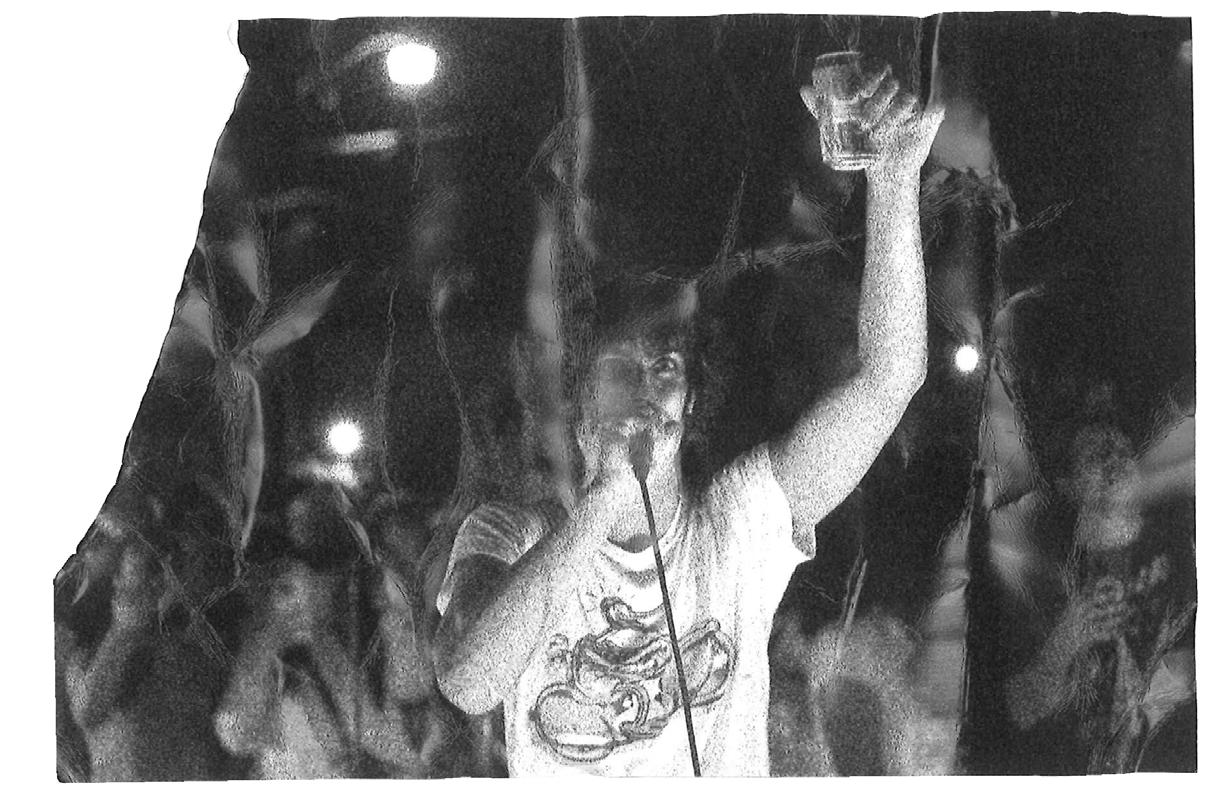

Six months after The All-American Rejects show rocked East Campus, Vox takes an inside look into how the KCOU staff made sure it all came together.
By Charlie WarnER



By Charlie WarnER

EditEd by Emma Zawacki
EditEd by Emma Zawacki
Photography by Russ Bray
Photography by Russ Bray
Photo illustrations and design by Valerie Tiscareno
Photo illustrations and design by Valerie Tiscareno

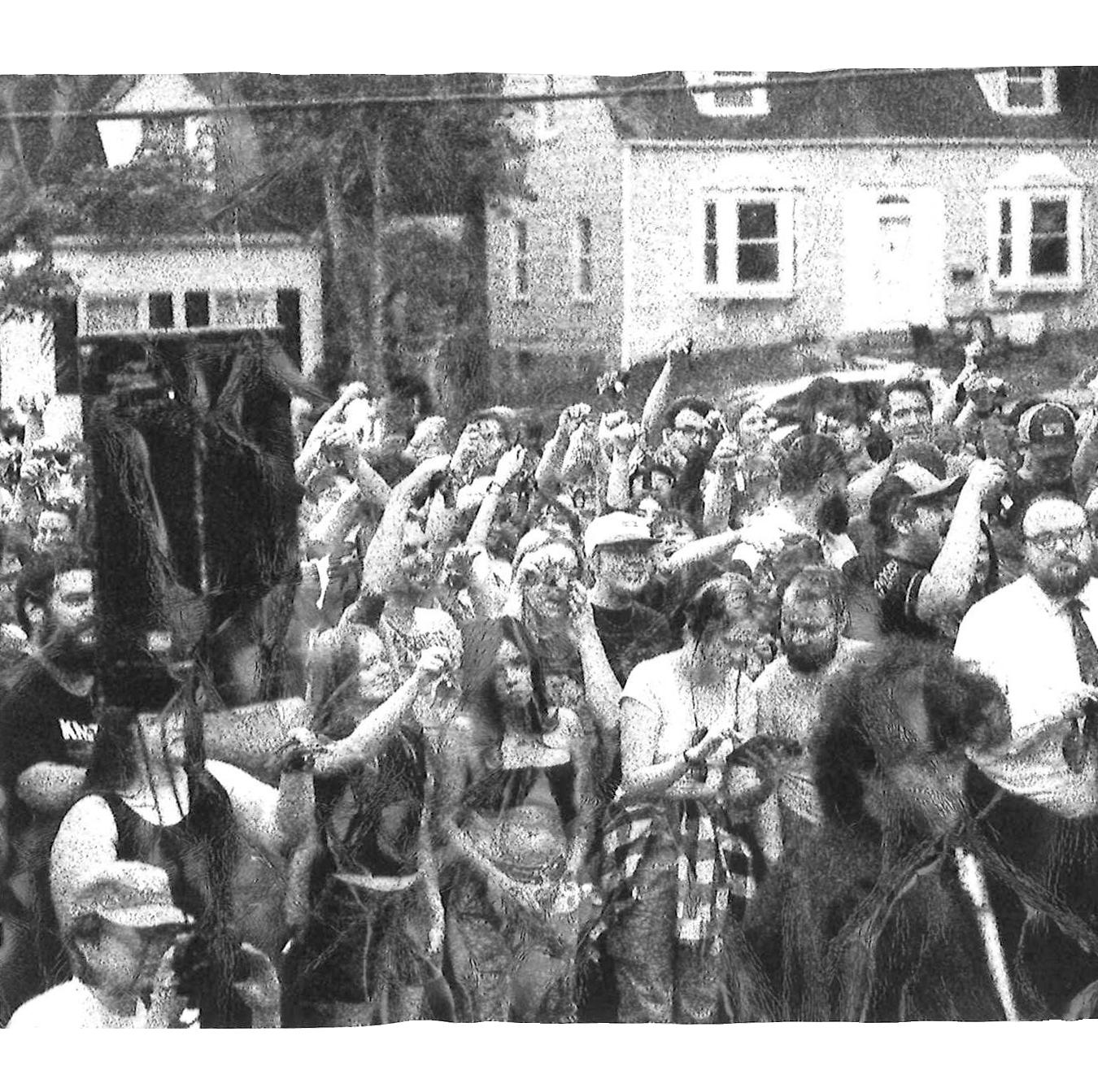







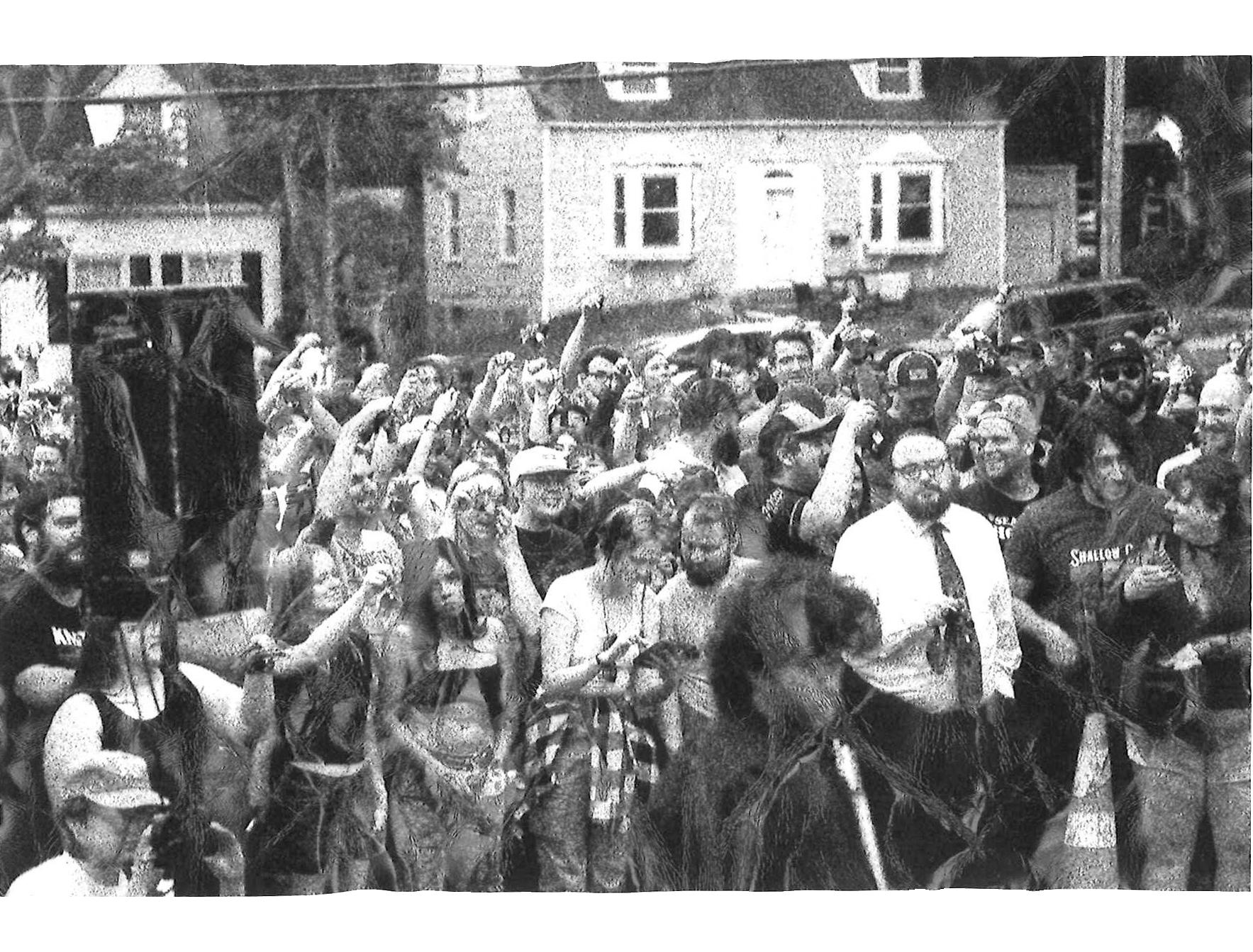
Let’s go back in time to 2008. It was before the nightmarish integration of technology into every aspect of life. Twitter and YouTube were budding platforms and “going viral” was a new concept. Beyoncé’s “Single Ladies” was climbing the charts and the Marvel Cinematic Universe hadn’t yet oversaturated superhero movies, as Iron Man had just been released. There weren’t “unprecedented times” seemingly all of the time. Life was good in 2008, right?
I wouldn’t really know — I was only 5 years old. So, take my waxing poetic with a grain of salt. I didn’t have a home to worry about during the mortgage crisis. I didn’t have loved ones fighting in the wars unfolding in Iraq and Afghanistan post 9/11. I wasn’t faced with the dot-com bubble bursting or trying to understand the new world-connecting platform of Facebook.
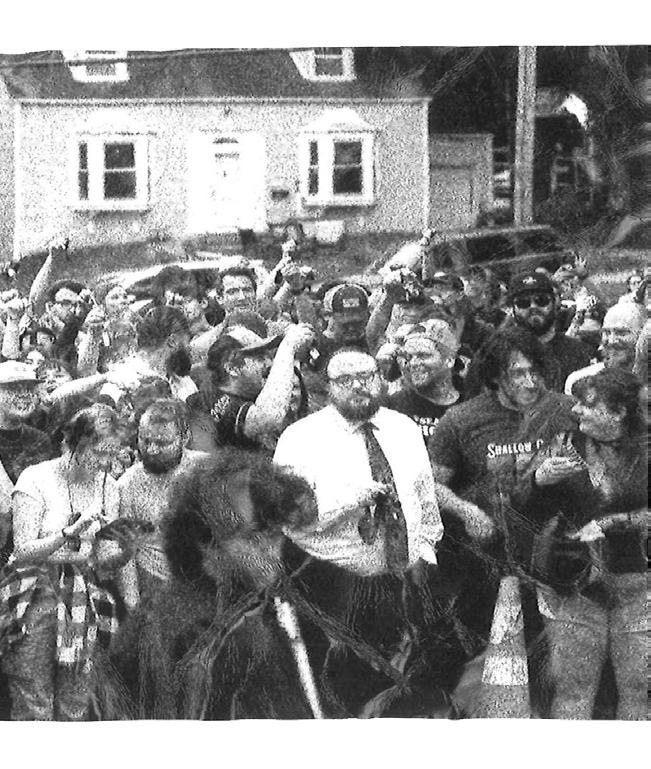



But, there is one thing I do remember from 2008: a hit song. A song so inescapable even tots like me were running around singing about an imaginary ex-girlfriend.
The song was “Gives You Hell” by The All-American Rejects, which was the most played song the year after it came out, according to Billboard
Over 15 years later, The All-American Rejects relaunched itself into the spotlight by going on a tour of DIY secret shows in an effort to connect directly with fans, while simultaneously avoiding unaffordable ticket prices from monopolistic companies like Ticketmaster. This led the band’s management to contact KCOU 88.1 FM, the University of Missouri’s student-run radio station, to plan a show in Columbia.
While Columbia wasn’t the first stop on the band’s house show tour, videos of the show on May 18 were a part of a wave of viral videos that garnered the tour even more attention.
Before the videos of spectators sitting on roofs and police shutting things down, it was up to KCOUers to ensure the band would be able to play in Columbia. The radio station staff quickly needed to figure out the logistics for hosting a 2000s band making a powerful comeback.
Here’s where I admit that I was initially conflicted about this show. I’m part of the KCOU staff — hosting my show “Warner’s World,” editing the station’s blog and holding an executive staff position. I’m also a guitarist in the band Pink Houses, which has played house shows all over East Campus.
By my judgment, the Rejects’ particular brand of pop-punk didn’t cut it, even though I sang along to “Gives You Hell” as a kid. In the weeks leading up to the show, I remember saying something along the lines of “people only like them for that one song. I bet they’re washed up and just want to party with college-aged girls again.”
But I also knew this was a really big deal — perhaps the biggest musical deal of my time in Columbia. Before I felt at home here, I’d read the 2023 Vox story about the Big Star reunion concert KCOU organized in 1993. That story was evidence that something truly rock ’n’ roll could happen in this city in my lifetime. It inspired me to become involved with KCOU. I knew the Rejects show was an opportunity for my generation of KCOUers to do something historic. Here’s how it all unfolded:
Spring is a busy time for KCOU. The station organizes a concert called Festival 88, or F88. On April 4, Chicago-indie band Friko headlined the event at The Blue Note, along with up-and-coming Kansas City rapper Paris Williams and The Park, stalwarts of Columbia’s DIY scene.
After the concert, it’s graduation season. Many station members leave for the summer or say goodbye to their collegiate careers. The station’s other big task in May is an election to fill vacated executive staff positions. That means both former and newly elected executives work together during this period around the F88 concert.
All this is to say, the last thing on any staffers’ mind in spring was planning yet another event.
Newly elected General Manager John Sansone was the first station member to learn of the show opportunity. He was in class on a Friday and received an email that he assumed was a scam. The email was from Allyson Clayton, the manager of The All-American Rejects, asking KCOU to host a secret pop-up house show for the band. “I just kind of sat there with it for a minute,” Sansone says. “I’m like, ‘I’ve got to tell someone about this. What if it’s real?’”
Sansone hustled to the station’s studio after class so he could discuss the email with other station members. Everyone he told about it felt similarly — a little hesitant, but anxiously hopeful.
After some correspondence with Clayton, a virtual meeting was set up for the following Monday with Sansone, the station’s music directors at the time, Lily Franck and Michaela Bailey (nicknamed MB) and the band’s managerial team. At the time,

When Via Amos (right), lead singer of The Park, found out they’d be opening for The All-American Rejects, she channeled her excited energy into a song the band was recording. 16 16
station members weren’t supposed to know about the concert since it was a part of a larger tour of surprise pop-up shows.

“(I) waited all weekend on my hands, hoping that this was still real,” Sansone says. “Finally, my self, Lily and MB had a Zoom meeting with Allyson, and it was real.”
After the meeting confirmed KCOU wasn’t being duped, a house to host the show needed to be found. Even before the meeting, it wasn’t a question of if KCOU would do it, but how. “It was definitely like, ‘no matter what, this is going to happen,’ ” Franck says. “We were going to do whatever to make it possible.”
The venue decision was easy, as Franck, Bailey and KCOU member Gillian Culhane lived in an East Campus house brimming with station history. Station members had been living and partying in this house for many years — it was the site of my first college party. “We were like, ‘yeah, we’ll host at our house,’ ” Franck says. “That’s the most perfect going out, final hurrah of being music directors and running the KCOU music staff.”
Rejects management also asked the station to book a DJ and an opening band. Billie Huang, a KCOU alum, photographer, visual artist, designer and performer was booked for the first slot as DJ Airfry. Huang is known for playing electronic music sets at Materia, a club in St. Louis.
For the opening band, there was one clear choice: The Park.
The Park, Pink Houses and another college band called Nightstand had become a trio of





As a host for “Warner’s World,” a Friday evening music show on KCOU, and a guitarist for Pink Houses, Charlie Warner knows a thing or two about the music scene in Columbia. Watching The All-American Rejects perform at a house that has been vital to his college experience left him with memories for a lifetime — and a novelty T-shirt.

















self-proclaimed “sister bands” during the school year, playing gigs together and forming friendships. As the most established group, The Park helped the other two bands start playing more shows. The members of The Park were veterans of the local house show scene, and everybody was excited to see them play in front of a huge crowd.
The Park’s singer, Via Amos, says she was ecstatic when Sansone pitched the idea of opening for the Rejects to her and guitarist Levi Case. They were in the KCOU studio recording vocals for the song “Keys,” featured on The Park’s album A Nearly Perfect Summer. Case also was part of KCOU (and Vox), serving as the station’s recording studio director. “Levi and I both called our parents and told them because we were so excited,” Amos says. “There was a lot of jumping and screaming.”
The rush of excitement became part of the song, which features cathartic screaming at the end. “I really wanted to get a take with all that excited energy.” Amos says. “So I went back in the booth and screamed my heart out.”
p.m. May 18: A grad buffet and gear load-IN
On the day of the show, I woke up around 2 p.m. — it was a Sunday, don’t judge — and started to prepare mentally. My roommate and fellow KCOU member, Braylon Thibeaux, and I decided to walk two houses up the street to see what was going on at the show site.
There, we saw a huge tour bus carefully backed into the narrow gravel driveway. The front porch of the house was decorated with a balloon arch and a Mediterranean buffet for Franck’s graduation party. It was quite the unusual combo to see rock stars and roadies mill about in their normal clothes while celebrating a friend’s graduation and eating gyros.
“I low-key didn’t think it was a real thing until we saw the tour bus rolling up,” Franck says.
Some guys from the station and I were enlisted to help the Rejects crew unload. I was in awe witnessing behind the scenes of a professional touring setup. Huge, heavy-duty crates carried so much gear — I didn’t even know what much of it did. It blew my amateur-musician mind.
After visiting Columbia, the band hit the road to host a similarly styled DIY extravaganza in Nashville. 17 17
After we moved the boxes out of the trailer, I was the best-ish person for the crew to ask about some sound-setup questions since I had put on





band’s lead singer, Tyson Ritter, emerged from the tour bus and familiarized himself with the lay of the land. Donning light terry cloth threads and sunglasses, he was the embodiment of a rock star enjoying some brief time off. For a singer in a band I didn’t personally care for, I was struck by the authentic bad-assery exuding from him. He pulled off this silly outfit in the daytime and off stage, which is the No. 1 sign a rock star truly has sauce. He found a lawn chair and an acoustic guitar and was strumming to prepare for another night of singing.
Yet there are levels to his persona, and behind the aloof coolness was authentic politeness. University of Missouri grad student Russ Bray was photographing the event for KBIA 91.3 FM. Looking to document every detail, Bray snapped some shots of Ritter in the lawn chair.
“We take photos and ask after (for permission), so I was taking photos of Tyson,” Bray says. “He said it very nicely, very respectfully, but he
was eager to be interviewed at that exact moment, meaning she had to ask questions off the top of her head. “It was a 20-minute interview,” Jenkins says. “He’s a good person to just talk to, so it felt more conversational.”
In addition to relaxing and fronting the show that night, Ritter spent time making genuine con nections with people he might never see again. Ear lier in the month, Ragtag Film Society announced it had lost some federal funding. The band had been donating to a local organization for each show. For the Columbia show, KCOU selected Ragtag and raised about $1,000 through the show to donate. Ritter also became intrigued by a painting that was hanging in the house of a woman cradling Mr. Ping, the adoptive goose stepfather from Kung Fu Panda. It was painted by Franck’s dad, Matthew, who had been painting as a hobby since 2012, but hadn’t ever sold any of his work. Ritter convinced him to sell the painting in exchange for a $500 donation to Ragtag. It now hangs in his child’s nursery.





Popular songs from The Park include “Anything Wrong,” “Riff is Riff” and “Hoarse.” Its members are Mikey Alexander, Via Amos, Levi Case, Katy Miller, Greyson Smallen and Will Thives. 18 18






My other duty for the day was to help The Park have a smooth experience. The band’s six members are full of personality, and things could sometimes get stressful. As people were arriving, I just hung around, helping when I could and taking everything in. I ate some of the food Franck’s parents had prepared. I helped set up some banners promoting the Rejects’ new song and was filmed drinking Surfside, a seltzer brand sponsoring the shows, by the band’s media guy.
Before go-time at 7 p.m., there was a flurry of final activity and anxieties before all the fans came flocking. We needed to find a rug to go under the drum set and the crew wanted to have Narcan on hand. They also wanted a few security guards just in case after the previous night’s Rejects crowd exceeded size expectations. In Ames, Iowa, the night before, 3,000 people showed up to attend the secret show at a barn. An additional 2,000 people crashed the gates.
“There was a bit of real fear a couple of days ahead of our show,” Bailey says. “And I really felt that fear, I’m not going to lie. They texted me and asked the night before — I had to find a team of security.”


The All-American Rejects’ most recent song, “Search Party!,” was released Sept. 18.
Greta Frymire, one of three incoming KCOU music directors, works at The Blue Note and Rose Music Hall. She was able to pull some strings to have a couple of those venues’ security guards work the event.
On top of that, people began to worry about police presence. The Columbia Police Department had been cracking down on East Campus events organized outside city permits, such as parties and house shows. CPD shut down the five-band Stop Day show on East Campus, which is normally a time students come together and celebrate the end of the school year. “The (band’s) managers wanted to avoid cops,” Bailey says. “Tyson was like, ‘bring it,’ as far as the cops were concerned.”
After everything was good to go, I ran back to my apartment to don my The Park shirt and grab my camera. DJ Airfry’s set started first. The crowd definitely was full of millennial-aged fans, especially since it was graduation weekend and the exodus of summer college kids had begun. The crowd seemed a little stiff listening to the club music. According to Huang’s blog post about the experience, Ritter said the DJ set “got them (the crowd) cold and warmed them up.”
Former KCOU Communications Director Noah Schmitz and I took turns using my camera to film The Park’s set. I was so proud seeing some of my best friends absolutely ripping it in front of a huge crowd that was starting to fill up toward the sidewalk and street.
Case had graduated earlier that day and decided to wear his gown to perform. He didn’t realize Ritter
was going to borrow Franck’s cap and gown for his show swag, and he cracked a joke walking out to perform that one of them had to change.
As the crowd grew, people became more invested in The Park’s commanding presence. “Everything felt kind of right,” Case says. “We were firing on all cylinders. I just remember being on stage and looking out into the crowd in the middle of the set. There were probably 30 to 40 people when we started, and by the end it exponentially increased. I could see my friends, I could see my mom and dad and sister, and it was just so beautiful. It felt like all of the work we put in as a band, all of the struggles that we had were kind of like, ‘hey, maybe it was kind of worth it.’ ”
For its last song, The Park pulled Sansone and Kenzie Ripe, the station’s exiting general manager, on stage to sing. “I thought it was really cool that we were able to pull something like that off,” Ripe says, “especially in the middle of Missouri.”
8:50
Once The Park finished the set and its gear was put up, I joined the crowd to party.
It was a sea of concertgoers at this point. KCOU’s Instagram flyer promoting the concert had been posted and taken down a couple of times due to worries of crowd size, and the house’s address had been written on sidewalks around the city. Plus the Rejects sent a text to

fans about the show. People had clearly figured out how to get there.
I was standing in the house’s side yard for the show. When Ritter came out wearing Franck’s cap and gown, everyone lost it. Nostalgia took over as the crowd sang every word. The band started the show with “Dirty Little Secret.”
Valeriya Sadova grew up listening to The All-American Rejects with her brother. She was in Columbia the morning of the show, and then drove back home to Jefferson City. Her brother asked if she wanted to go to a house show in Columbia that night, but she wasn’t too keen on the idea until realizing it was the Rejects, so she drove back to see the show. “I thought it was cool,” Sadova says. “Tyson was such a great performer. He engaged with the crowd. I loved seeing the people on the roofs.”
9:45 p.m.: “That’s the sound of the police”
The show was smooth sailing until Columbia Police Department squad cars arrived and parked on the street. Officers stood on the opposite sidewalk and watched before eventually moving over to the show to enforce the noise ordinance. Ritter ate his words about “bringing on the cops” as Bray snapped a photo of his surprised face when police actually did show up.
“Everybody booed when the cops showed up,” Sadova says.



In true East Campus fashion, when there were no more ground-level viewing spots, crowd members got creative and clambered onto rooftops.













During the last song, writer Charlie Warner says he got hit in the head with a T-shirt that read, “I got fucked up at The All-American Rejects house show.” He wasn’t alone.

cial than a typical house show, the police didn’t immediately break things up. They talked to the band’s management and said they were fans and allowed for one more song: “Gives You Hell.” Actually knowing the lyrics to this one, I joined the crowd in the collective effervescence. It was blissful shouting the bitter lyrics that often were stuck in my head growing up.
After observing Ritter’s demeanor before the show and watching the band seamlessly tear through a set while constantly switching instruments, my opinion of the band began to change. When I first heard the members of The All-American Rejects wanted to play a house show in Columbia, I thought they were desperate. I thought they were doing it out of necessity, that they couldn’t get booked. I honestly thought it was sad. I also felt salty that they were going to blow out of the water the magnitude of any East Campus house show I could ever
pop-up house show tour was truly the most rock ’n’ roll thing to happen in mainstream America in so long. It didn’t fret about ticket sales or milk fans for even more money — just putting on a “come as you are” house show is what it’s all about.
As 2025 creates anxieties similar to those in 2008 — war in the Middle East, distrust of the media, rising use of new technologies, a looming recession and high inflation — this Rejects tour will be a milestone in our cultural ice age.
It was wild to see music publications such as Rolling Stone, Stereogum and Pigeons and Planes posting images of the house where I would casually spend weeknights hanging out with my college friends. The Rejects really pulled out something special with this tour, and I hope it inspires America’s pop-culture identity to shift back toward events that allow for genuine connection, rather than worrying about being the most Instagrammable and cross-promotional event ever.











STORY AND GRAPHICS BY
EDITED BY Jazmyne Martinez




DESIGN AND ILLUSTRATIONS BY


The U.S. lags behind the rest of the developed world in the fight to reduce maternal deaths. Structural barriers, pregnancy complications and rural health care gaps all play a role. As access to maternal care unravels, programs in Missouri work to assure more mothers make it to motherhood.

Maternal motality is the umbrella term that describes different causes of death during and after pregnancy.
PREGNANCY-RELATED DEATH

This includes deaths up to one year postpartum from a pregnancy complication, a series of events caused by pregnancy or an aggravation of an existing health condition due to pregnancy.
PREGNANCY-ASSOCIATED DEATH
This is defined as a death up to one year postpartum regardless of cause.

IIt’s a familiar cliché: Mothers describe meeting their children as the best day of their lives. Yet, for some mothers, that joy is interwoven with pain and grief from pregnancy-related health complications, postpartum depression or other life-altering circumstances. As many as one in three mothers endure a traumatic birth, which might mean a long and arduous labor or a life-threatening emergency. Some mothers wear these experiences as a badge of honor — others carry their birth stories with a heavy heart or would prefer to forget them entirely.
And still others do not live to tell their stories, or grieve or forget.
There are more than 700 pregnancy-associated deaths each year in the United States. This includes any death that occurs during pregnancy or up to one year postpartum. Cardiovascular issues, infection, homicide and mental health and substance use disorders are the top causes, according to the Office of Research on Women’s Health. Additionally, pregnant people are more vulnerable to reproductive health complications if they are also enduring other traumatic circumstances, such as intimate partner violence or substance use disorders. In Missouri, there is an average of 70 pregnancy-related deaths each year — accounting for 10% of the deaths nationwide. And many of these deaths are preventable. According to data from Missouri’s most recent Pregnancy-Associated Mortality Review, 80% of the deaths between 2018 and 2022 could have been avoided. (2022 is the most recent data available because the review board assesses each death on a case-by-case basis before publishing any official numbers.)
Maternal mortality is a looming threat that’s compounded by racial and economic disparities, mental health risk factors and insurance access. Mothers caught in this web of circumstances face higher risks of disease, infection, violence and other complications that could have fatal consequences.
To counter these threats to Missouri’s mothers, there is a group of Missouri researchers and caregivers who work tirelessly to eliminate preventable maternal deaths.
Out of 100,000 live births in Missouri, 32 result in a pregnancy-associated death — that’s the seventh-highest rate in the country. While rural health care deserts increase such risks for mothers, medical racism and socioeconomic disparities also create conditions that put lower-class mothers and mothers of color at the highest risk.





Year after year, Black women face the brunt of pregnancy complications in Missouri and have the highest maternal mortality rates. Black women are more than twice as likely as white women to die during or shortly after birth, a rate that has fallen in the past five years but remains well above the state’s median maternal mortality rate. Black mothers in Missouri are also twice as likely as white women to face severe health complications during pregnancy, including respiratory distress, sepsis and the need for a blood transfusion, according to the Missouri Department of Health and Senior Services.
To fight against these staggering maternal mortality rates, mid-Missouri researchers and care providers are working to uncover better solutions to the maternal mortality crisis.
In January, MU Health Care launched the Heart Outcomes in Pregnancy Expectations study, national research hosted by MU that examines 34 obstetrical care sites across the country. The National Institutes of Health-funded study will help unpack risks to mothers’ cardiovascular health and search for ways to reduce maternal mortality.
One of the principal investigators is Karen Florio, a maternal-fetal medicine specialist at MU Health Care and the hospital network’s vice chair of OB-GYN patient safety and quality. She says it’s important that Missouri researchers spearhead maternal mortality research that could have nationwide health care
implications. “I think that people just view Missouri as a flyover state,” Florio says. “We’re changing the narrative because we do live in a state where we have some of the highest maternal mortality rates, and we’ve recognized that, and we want to do something about it.”
Like many of her patients, Florio has survived severe complications as a result of a pregnancy. To this day, she lives with cardiovascular symptoms that affect her quality of life. She says her lived experiences have propelled her to reshape the maternal health care landscape in Missouri.
“This is my lifelong work,” Florio says. “It means the world to me to impact other women’s lives in the same way, or in a better way than my life was impacted and try to ensure that they not only survive these pregnancies but thrive and have a quality of life following their delivery.”
The Perinatal Quality Collaborative is another effort in the state. It was formed in 2023 through the Missouri Department of Health and Senior Services. It aims to address systemic failings that leave mothers at risk of pregnancy complications and premature death. The collaborative’s initiatives address top causes of death for pregnant and postpartum people, including cardiovascular health and complications from substance use disorders. In the last two years, 51 of Missouri’s 59 birthing hospitals have participated in initiatives to reduce systemic barriers to quality care.
From 2020 to 2022, Black women were 2.5 times more likely than their white counterparts to die a pregnancyassociated death. That is lower than 2017 to 2019, when Black women were more than three times as likely to die than white women, but the number of deaths to live births for Black women is still climbing.
Source: Missouri Department of Health and Senior Services








Maternal mortality rates spiked in Missouri in 2020, according to the Pregnancy-Associated Mortality Review. This is likely due to pandemic-related disruptions to care, higher exposure to infection and existing health care inequities, according to a study from Brown University. Since then, the state has instituted several policy changes that experts say will reduce pregnancy-associated deaths.
Most notable among those changes is the 2023 expansion of Medicaid to cover all mental and physical conditions up to one year postpartum to ensure every mother has access to care while recovering from pregnancy and birth. That means the 40% of births that are covered by Medicaid in Missouri now include this postpartum care. This change, which was recommended by the Missouri Department of Health and Senior Services, was consistent with the federal government’s Maternity Care Action Plan through the Centers for Medicare and Medicaid. Missouri became the 40th state in the country to implement postpartum Medicaid coverage.
While Medicaid funding is on the chopping block at the federal level, Missouri’s Medicaid expansion is enshrined in the state’s constitution. This means even in the face of federal cuts, the state is required to provide postpartum Medicaid coverage with or without the federal government’s help, according to Missouri Independent reporting.
“It’s an extremely rare scenario that I run into someone who doesn’t have one type of insurance or another,” Borgmeyer says. “We have a lot of Missouri Medicaid for pregnant women, and that seems to be a relatively easy thing to get because the income cutoffs are significantly higher than general Medicaid in pregnancy.”
Even though Medicaid expansion is a preventive measure to reduce maternal mortality, the Pregnancy-Associated Mortality Review found that Missouri Medicaid recipients were 2.8 times more likely to die in childbirth than non-Medicaid recipients. That paradox exists because Medicaid serves low-income, working-age adults. Because this group has fewer financial resources, they are more likely to experience other risk factors for pregnancy complications, such as delayed medical visits, less paid maternity leave, substance use disorders and food insecurity. Medicaid provides a key safety net to protect the most vulnerable mothers in Missouri — but it has its limits.
Ensuring that all Missourians have access to maternal health care goes beyond paying for the quality of the care itself — it includes where that care is located.

Matthew Borgmeyer, an OB-GYN doctor at Boone Health Women’s Health Associates, says the vast majority of his patients have coverage either through Medicaid or private insurance. This is a major victory for maternal health that would not be possible without Missouri’s Medicaid expansion.

According to the March of Dimes, a maternal health research and advocacy organization, almost 42% of Missouri’s counties are maternal care deserts, which means maternal care is limited or completely unavailable. The northeast region of Missouri, which has a maternal mortality rate about twice as much as the central region, is home to only five maternal care facilities. By comparison, the central region — which includes Columbia — has eight of the state’s 36 maternal care facilities that are outside the Kansas City






There are 60 maternal care facilities in Missouri overall. Only five are located in the state’s Northeast region, which has the highest maternal mortality rate in the state. The areas with fewer facilities have higher rates of pregnancy-associated deaths.
Labor and delivery hospitals and facilities
Rate of pregnancy-associated deaths per 100,000 live births
and St. Louis metropolitan areas. (Those two metro regions have a combined 24 birthing facilities.)
And access to maternal health care in rural areas is only declining, Borgmeyer says. As maternal health care facilities concentrate in more urban areas with greater economic resources, many mothers are left in obstetric care deserts that require them to drive over an hour for the regular in-person appointments that are recommended in the last trimester of pregnancy. Such access is critical. “Trying to figure out when (a symptom) is not normal is hard to do over the phone,” Borgmeyer says.
In rural areas, the nearest OB-GYN might not even be able to handle anything beyond uncomplicated pregnancies. For mothers with serious, life-threatening complications, the nearest hospital equipped to treat them may be several hours away.
To bridge this care gap, Boone County offers home visits to mothers and families through its Brighter Beginnings program. This program offers individual home visits and parental education programs to families in the county, but its parent program offers similar services throughout the state. Kelly Scheuerman, the program coordinator for Brighter Beginnings, says Boone County is the only county that hosts its own program. Because of that, Brighter Beginnings works closely with both city of Columbia and Boone County

Northwest data not available due to a low volume of cases.
Source: Missouri Department of Health and Senior Services
Unlike the rest of the developed world, which saw maternal mortality decrease by 44% since 1990, maternal mortality in the United States is high and rising. It grew by a staggering 27% after the pandemic, according to a 2025 review from the National Institutes of Health, which calls maternal mortality an urgent public health priority.



Despite this warning, the federal government is gutting programs that help us understand and combat maternal mortality. ProPublica reported in April that the Department of Health and Human Services, under the direction of the Trump administration’s Department of Government Efficiency, paused the federal government’s main tool for collecting data on the country’s high maternal mortality. These cuts came in response to sweeping changes under Secretary of Health and Human Services
Robert F. Kennedy Jr., who has announced his intention to cut a quarter of the staff in the department in conjunction with DOGE cuts.


governments and Central Missouri Community Action to care for Boone County mothers and families. Scheuerman says the variety of access points means the program connects mothers and families to time-sensitive care as soon as possible without a waitlist. “The importance of early intervention is what is going to turn the curve with better outcomes for maternal health and infant health,” Scheuerman says. “We’re always here to be a support to help and guide you.”
The Brighter Beginnings partner organizations cover a wide range of maternal and family needs, including staff interpreters to work with non-English speaking families. Scheuerman says such resources are key to building lasting relationships. “Particularly in our refugee and immigrant families, sometimes they can take a minute to build that rapport,” Scheuerman says. “If they’ve had a positive experience, they’re more likely to share that experience within their community.”
Findings from the 2025 Pregnancy-Associated Mortality Review show that mental health is the leading cause of maternal mortality, with conditions such as depression, anxiety and substance use disorder contributing to nearly one in three pregnancy-associated deaths in Missouri. MU Health Care’s Maternal Health Access Project seeks to reduce these complications by giving Missouri’s obstetric providers access to psychiatric consultations, education and support coordination to better treat their patients.
After more than a year since the program started in April 2024, it has enrolled providers in over 60 counties in Missouri, says Nicole Cope, executive director of the project. One-fifth of those providers are in rural areas, and over 70% serve patients in medically underserved areas in the state, Cope says.
These are both key factors in getting such care to the people with the most limited resources. Principal investigator Laine Young-Walker says the project aims to bridge a major maternal care gap in Missouri by equipping providers to respond to warning signs early. “We know that maternal mortality is highest due to mental health diagnoses and also substance use, so that’s the target,” Young-Walker says. “How can we help those people who take care of perinatal patients in the realm of mental health and substance use where they may not be experts?”
Missouri remains center stage in the battle to reduce pregnancy-associated death. But without structural change to combat medical racism, socioeconomic barriers and rural health care deserts, more Missouri mothers will die preventable deaths. In the most recent Pregnancy-Associated Mortality Review, board members suggest we still have a long way to go to make Missouri safer for mothers. The board recommends changes far beyond the scope of the medical system that would improve overall quality of life for mothers, including prioritized affordable housing for pregnant and postpartum people, community violence intervention programs and investments in urban infrastructure. At the center of each of these policies or initiatives is a vulnerable person. Right now, they are setting up their baby’s nursery, folding tiny clothes into an heirloom dresser. Or they have been on their feet for 10 hours, working a double shift so they can start their baby’s savings account. They are neighbors, relatives, coworkers and cherished friends, and they deserve a robust public health infrastructure that allows them to thrive.








Savory or sweet, flaky or fluffy, these Columbia spots offer a variety of biscuits to fill your belly and warm your soul.
BY ALLISON BEALMER
After JoJo’s Biscuit Company opened in Columbia in September, the Vox staff started thinking about how many businesses in town serve biscuits. From Southern staples to creations you might not have seen before, there’s a local spot that covers every craving.
These biscuits show how creative Columbia’s kitchens can get when flour, butter and a little imagination come together. Vox talked to six of the city’s biscuit bakers to create this guide about all things fluffy, buttery and savory.
The new biscuit on the block: JoJo’s Biscuit Company
When JoJo’s Biscuit Company quietly opened its doors in Columbia, the community was quick to catch on to the new spot. It started off as discreetly feeding Mizzou athletes to test the menu and train cooks then quickly became a bustling business.
Jason Paetzold, the Texas-born owner, who also owns Bud’s BBQ, was naturally inspired by his roots to start with a traditional Southern biscuit. However, he didn’t stop there.
“Those biscuits, we really shoot for a crispy top,” Paetzold says. “Just that caramelization, that browning of the biscuit itself gives it some really toasted
notes that are really tasty.”
You can expect sweet spreads that include an in-house salted caramel apple butter called JoJo Butter, a lemon mascarpone and wild Maine blueberry compote. Or if you’re looking for savory sustenance, you’ll find biscuit sandwiches with hot chicken and pimento cheese and biscuits and gravy made with housecured bacon and house-made sausage.
“After living here in Columbia, I wanted to create something special that was really Columbia’s own,” Paetzold says.
Where: 2540 Broadway Bluffs Drive, Suite 111
Hours: 7:30 a.m. to 2:30 p.m.
The biscuit spotlight: Ozark Mountain Biscuit & Bar
At Ozark Mountain Biscuit & Bar, the biscuit is the foundation — classic, Southern-style and made the old-fashioned way.
“Picture your favorite food, now picture it on a biscuit,” says Bryan Maness, owner of Ozark Mountain Biscuit & Bar. “That’s what we do.”
Just six simple ingredients, no preservatives, no additives and always from scratch. They’re baked fresh throughout the day so they land on the plate hot, fluffy and ready to hold whatever comes next.
That whatever comes next is where the fun begins.
“I kind of make the joke — because it’s a great biscuit — but it’s just a biscuit,” Maness says. “You know, you can’t really improve upon it too much. It’s what it is. Around that item is when we have fun.”
The sweet and savory fillings change with the seasons: once for spring and summer and again for fall and winter. Weekly specials also make surprise appearances.
Where: 1204 Hinkson Ave.
Hours: Mon.–Fri., 8 a.m. to 9 p.m.; Sat.–Sun., 9 a.m. to 9 p.m.
Call: 573-447-6547
Rise & shine: Sage
Over at Sage, the kitchen is rolling out baskets of warm, flaky biscuits with sides of jam or honey, or hearty gravy.
“It’s so good,” says Sophia Landrum,
There’s no dairy or gluten in Nourish Cafe & Market’s biscuits and gravy.


line cook at Sage. “(The biscuits are) my favorite thing there.”
But what really makes them stand out is their finishing touch.
“Our biscuit is actually glazed with maple syrup, which gives it a really glossy and caramelized, shiny top,” Landrum says.
That glaze doesn’t just add shine, it layers in sweetness with the biscuits’ savory flavor. “The biscuits have a savory and buttery taste, and then with the maple glaze on top it adds some sweetness,” Landrum says. “So I’d say it’s a little savory, a little sweet. (It) kind of hits both.”
Where: 11 N. Ninth St.
Hours: Mon.–Sat., 7 a.m. to 4 p.m.; Sunday, 8 a.m. to 2 p.m.
Call: 573-449-8215
layers: Cafe Berlin
At Cafe Berlin, biscuits aren’t dainty; they’re bold, rustic and brimming with personality.
“Lots of love, lots of wheat flour,” says Samuel Johnson, co-owner of Cafe Berlin.
These biscuits rise to 2.5 inches and strike the perfect balance — fluffy yet
“I grew up on biscuits and gravy, and you know, that was such a Midwest staple,” says Kalle LeMone, owner of Nourish Cafe. LeMone says she wanted to make sure diners with food restrictions could still enjoy the classic meal, which lead to Nourish’s dairy and glutenfree biscuits and gravy (above).
crumbly and buttery with just the right hint of salt. Just when you think it’s all savory, a whisper of brown sugar sneaks in to make it unmistakably a Cafe Berlin biscuit.
However, it’s not just about the biscuits themselves.
“We love biscuits and we love this town,” Johnson says. “With everything going on in the world, we forget how essential food is and how it brings people together.”
The fun doesn’t stop there. Cafe Berlin has been tinkering with a new recipe, swapping in vegan butter to create a plant-based biscuit that still packs flavor. Expect it to land on the menu in the next couple of months.
Where: 220 N. Tenth St.
Hours: Daily 8 a.m. to 2 p.m., 6-10 p.m.; closed Tuesdays Call: 573-441-0400
The ultimate biscuit mix-and-match: The Biscuit Center
At The Biscuit Center, choosing just one flavor isn’t required. It’s a biscuit lover’s version of a choose-your-own adventure, with everything from classic Southern-style biscuits to a bright strawberry Pink Delight.
Owner Scott Pass didn’t start out making plain biscuits either. “I think the first biscuit I made was a sausage, egg and cheese where everything was actually in the biscuit,” he says.
Today, the menu spans both sides of the spectrum: savory options like bacon and cheddar biscuits and sweeter ones like French toast or strawberry. The classic biscuit sits balanced right in the middle.
“If you actually bite into it, actually pay attention, it has a little bit of everything in there.” Pass says.
There’s also room for variety. Customers can keep it simple with a buttered biscuit and jam, or they can build sandwiches with combinations of sausage, egg, cheese, chicken or gravy. The menu has grown to include six flavors, plus a gluten-friendly biscuit.
Where: Columbia Farmers Market, 1769 W. Ash St.
Hours: October: Saturday, 8 a.m. to noon; November: Saturday, 9 a.m. to noon Call: 573-825-5597
“WE LOVE BISCUITS AND WE LOVE THIS TOWN. WITH EVERYTHING GOING ON IN THE WORLD, WE FORGET HOW ESSENTIAL FOOD IS AND HOW IT BRINGS PEOPLE TOGETHER.”
—SAMUEL JOHNSON, CO-OWNER, CAFE BERLIN

Bold personality A whisper of brown sugar gives Cafe Berlin’s biscuits an unmistakable taste.


All about the biscuit Biscuits are a focal point at

Southern


There are more biscuits to bless your tastebuds at these local eateries.
Beet Box: Black Garlic Biscuits
Big Mama’s Cafe: Biscuits and gravy
Broadway Diner: Biscuits and gravy
Ernie’s Cafe & Steak House: Biscuits and gravy
Glenn’s Cafe: Biscuits and gravy
Uprise Bakery: Biscuits and gravy, sausage biscuit
An allergen-friendly take on comfort: Nourish Café & Market
For Kalle LeMone, the owner of Nourish Café & Market, biscuits and gravy aren’t just comfort food — they’re a Midwest memory.
At Nourish, those comfort-food roots received a thoughtful makeover.
The biscuits, created by one of the founders, were designed to be both dairy- and gluten-free, with a touch of yogurt to round them out. The gravy started as chicken sausage, but has since become a local pasture-raised pork sausage gravy — still completely dairy free.
“There have been tweaks and changes,” LeMone says, “(but) understanding comfort and realizing you can eat indulgent, nostalgic things without feeling like you can’t move the rest of the day.”
Where: 1201 E. Broadway, Suite B
Hours: Tues.–Fri., 7:30 a.m. to 2:30 p.m.; Sat.–Sun., 8:30 a.m. to 3 p.m.
Call: 573-818-2240




The CARE program placed Elijah Sparks in the Fiddle & Stone kitchen — and a passion for baking in his heart.
BY SOPHIE LINDBERG
It’s week one of training, and Chris Foley is trying to form 16-year-old Elijah Sparks into a self-sufficient baker — an impossible goal for the first week. Sparks is following Foley’s every movement in Cafe Berlin’s back kitchen, the home base of Fiddle & Stone Bread Co., as they fold the chilly bread dough. Foley’s band T-shirt has dough smeared down it, and Sparks is covered nearly head-to-toe in flour as he works to retain the information overload of protein percentages.
It has been four months since Sparks was a trainee with the Career Awareness
Related Experience, or CARE, program through the city of Columbia. It places trainees ages 14 to 20 in worksites starting in late June. They are trained up to 25 hours a week in a real work environment. This year, there were 130 trainees and over 80 worksites — some new, some returning. Trainees can gain workplace experience, while businesses gain an employee paid for by the city. Fiddle & Stone was new to CARE this year, and Sparks was the lone trainee placed at the business. Trainees often get a job offer by the end
Chris Foley cuts up a butternut squash while Elijah Sparks prepares the sourdough for one of Fiddle & Stone’s fall specialty flavors. Foley says time is the most important ingredient when making bread, along with flour, water, salt and love.
of the summer, which Sparks did. Now, as coworkers, the two work in tandem. Foley portions, scores and shapes the proofed dough with a justwinging-it attitude, while Sparks measures dry ingredients with precision. Foley’s tee is still covered in handprints of dough, but Sparks’ shirt isn’t. He leaves his shift on a Sunday morning almost untouched by ingredients. The two work together seamlessly but are complete opposites in their approaches to baking. Sparks has trained with the CARE program for three summers. He held
positions as a teacher’s assistant at Grant Elementary School and a camp counselor at Hexagon Alley. Baking at Fiddle & Stone was the first job where Sparks discovered a sense of purpose. “I thought I wanted to be a math teacher for a long time, and after working with enough kids, that’s no longer my dream,” Sparks says. “(CARE) allowed me to cross things off and not spend $30,000 of college debt getting a degree in something that I don’t want to do.”
The recipe
Ron Schmidt, supervisor of the CARE program, says restaurants and other food-related businesses often are good entry-level positions. “Every year, 130 youths are going to be better employees than if our program didn’t exist,” Schmidt says. “The better trained our employees are when they walk into that first or second or third job, the better off the entire community is going to be.”
Now as an employee of Fiddle & Stone, Sparks primarily measures the ingredients for mixing. He enjoys the
precision of weighing by the gram, following the procedure to a T and cranking out seven to 12 perfectly matching batches for up to 200 loaves every shift — no surprises, no deviations. The predictability is relaxing. He even took time during his CARE placement to put all of Foley’s recipes — which used to live solely in his head — on paper.
“Chris is the best boss I’ve ever had because he doesn’t expect anyone to do anything he won’t do, which is the best rule ever,” Sparks says. “It’s the most healthy work environment I’ve been a part of.”
Sparks knew he wanted to work in a bakery, but wasn’t getting anywhere. Fiddle & Stone became Sparks’ top placement preference through CARE.
Looking inside the kitchen on a normal Sunday morning, the pair is harmonious. Few words regarding actual work are exchanged, but they predict each other’s routines. If Foley goes to empty the mixer into a big proofing bin, Sparks
Fiddle & Stone offers many types of bread, each with a unique name. Some include Sesame Street Sour, Tuscan Sunset, Rosema-rye, Rye Guy, Seed Feast and many others. You can find them at the Columbia Farmers Market or one of the stores and restaurants that carry the bread, including Clovers Natural Market, Pierpont General Store, Flyover and Main Squeeze. Learn more at fiddleandstone.com.
gets out a lid and waits for the dough to be emptied into it. This synergy comes from a summer’s worth of Foley learning to train. “At the beginning, I was kind of training (Sparks) to be another me,” Foley says.
For something that didn’t come naturally at first, Foley’s training philosophy was to teach Sparks how to do every step — from measuring ingredients to handing the bread to customers. The tasks Sparks enjoyed the most became his responsibility.
The Fiddle & Stone kitchen had been a one-man, seven-days-a-week show, with some occasional help from Foley’s mom, pushing out orders for stores Clovers Natural Market and Pierpont General Store and restaurants such as Flyover and Main Squeeze. This was before Sparks, whose help allowed him to take a week-long vacation over the summer for the first time in 15 years — while still getting the bread orders out.
“Having an extra set of hands around,” Foley says, “is just invaluable to me.”



From the Blind Boone Home to Indigenous culture, our region of Missouri has a deep yet complicated history that is showcased at a variety of museums.
BY NAOMI M. KLEIN
Missouri is a gold mine — or should we say salt mine — of history. People often overlook the state in their American history books, shrugging it off as just another Midwestern stop. But sitting just west of the Mississippi River, and as a part of the Louisiana Purchase territories, Missouri was integral to settlers looking to expand westward.
So much of America’s history has taken place here — Civil War battles, journeys across the Oregon Trail and the launch of the Pony Express. Missouri also has a history of colonization, which drove out Indigenous people whose roots were planted in the state’s soil and enslaved African American people until 1865.
Vox compiled a list of a few noteworthy historical sites and museums across mid-Missouri, all within a 2-hour drive.
Arrow Rock State Historic Site
39521 Visitor Center Drive, Arrow Rock
Once a hub for salt production and trade, Arrow Rock is now a small village of about 70 citizens. Its visitor center holds artifacts from the Civil War and the War of 1812, along with donated Indigenous belongings. Paintings by artist George Caleb Bingham and artifacts from physician, farmer and medical pioneer John Sappington — both having worked in Arrow Rock — also are exhibited. The town is home to sights like the African American History Museum, the Lyceum Theatre, J. Huston Tavern and the Old Courthouse. Tram tours begin at $15 for adults at the Friends of Arrow
Rock headquarters on Main Street.
Hours: March to November: daily, 10 a.m. to 4 p.m.; December to February: Fri.–Sun. 10 a.m. to 4 p.m.
Find out more: mostateparks.com
Boone County History and Culture Center
3801 Ponderosa St.
The center blends history and art with rotating exhibits, family events and driving tours of historical buildings. For those who can’t make it in person, the culture center has digital photography and artifact collections on its website, along with virtual programs for those who are curious about what they have.
Hours: Wed.–Sat., 10 a.m. to 5 p.m.
Find out more: boonehistory.org
Historic Blind Boone Home
10 N. Fourth St.
This Victorian home once belonged to J.W. “Blind” Boone, a Black pianist and ragtime composer born in Missouri. Inside are two historic pianos, including a practice piano believed to have belonged to Boone. Recordings of some of Boone’s compositions and a free virtual tour of the house are available on its website.
Hours: By appointment
Price to tour: Varies based on event and size of group
Find out more: blindboonehome.org
Missouri’s American Indian Cultural Center
32146 N. Hwy. 122, Miami
Nine Indigenous tribes made their homes in Missouri in the early 19th century: Delaware, Illini-Peoria, Ioway, Kanza, Kickapoo, Osage, Otoe-Missouria, Sac and Fox and Shawnee. Located

“Imagine, discover, experience,” reads a wall at the Boone County History and Culture Center, where Mary Ellen Lohmann (above) helps her daughter Lydia dress up in a period-typical outfit. At the historic Blind Boone Home, see artifacts like posters (right) and a piano belonging to famed composer J.W. “Blind” Boone.
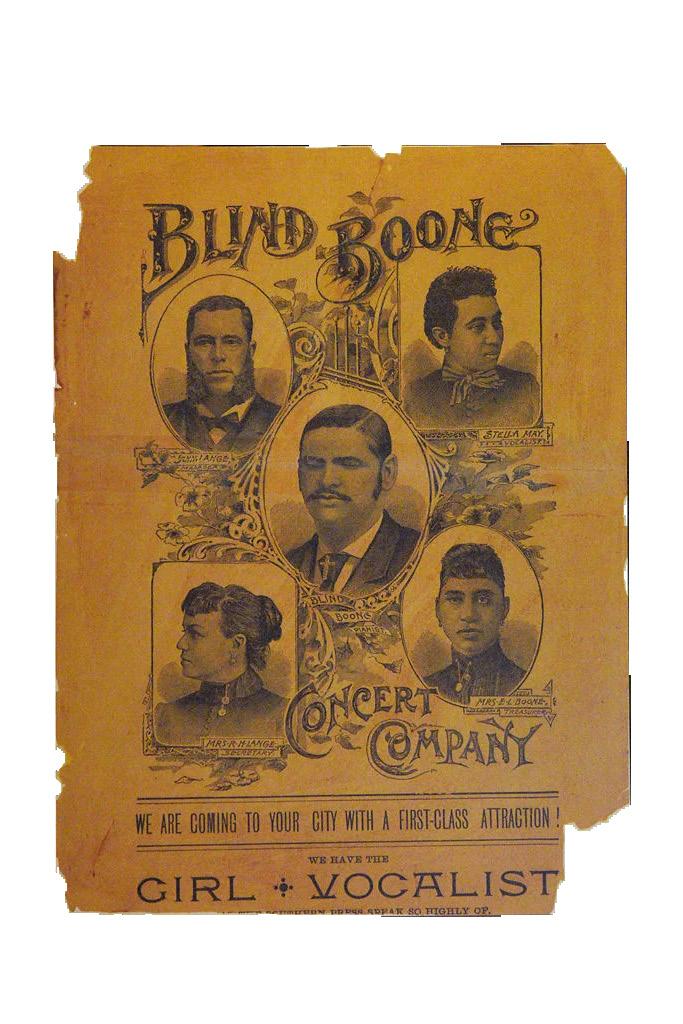
Learn more at these events.
At Boone County History and Culture Center, join Boone Youth Explorers to participate in activities that deepen the appreciation of local veterans from 10 a.m. to noon Nov. 8 at the Montminy Art Gallery.
The State Historical Society of Missouri hosts author Sean Rost to discuss his new book detailing the KKK in Missouri at noon Nov. 12 at the Center for Missouri Studies.
artifacts honoring the Indigenous people who where driven from the territory. Tours begin with a 10-minute film, and visitors can pick up free audio guides.
Hours: October to March: Saturday, 10 a.m. to 4 p.m., Sunday, noon to 4 p.m.; April to September: Thurs.–Mon., 10 a.m. to 4 p.m.
Find out more: mostateparks.com
State Historical Society of Missouri
605 Elm St.
SHSMO has six sites across the state — with one located in downtown Columbia. Visitors can conduct research in the library and view historic documents, records, newspapers and artifacts. The society also curates art and history exhibits alongside permanent displays. Whether you’re starting to learn about Missouri’s general history or researching niche topics, this free public resource offers both open access and expertise. Make an appointment for guaranteed library access.
Hours: Tues.–Fri., 8:30 a.m. to 4:30 p.m.; Saturday, 10 a.m. to 2 p.m.
Find out more: shsmo.org/visit/columbia
Your curated guide of what to do in Columbia this month.
BY AUGUSTUS HENDERSON AND JACKSON WEST
The Rocky Horror Show
Columbia Entertainment Company, now in its 46th season, presents cult sensation
The Rocky Horror Show, which inspired the 1975 movie The Rocky Horror Picture Show. After getting stuck in a storm, characters Brad and Janet experience a host of wild characters. The production, recommended for ages 18 and up, includes props the audience can use to participate in the show. 7:30 p.m. Oct. 30-Nov. 1 and Nov. 6-8; 2 p.m. Nov. 2 and 9; Columbia Entertainment Company, $20; $15 seniors and students, 573-474-3699
Into the Woods
Catch the University of Missouri Department of Theatre’s production of Into the Woods — a blend of several Brothers Grimm fairy tales. The play, directed by Joy Powell, examines the consequences brought on by the characters’ wishes and quests. 7:30 p.m. Nov. 6-8 and Nov. 13-15; 2 p.m. Nov. 9 and 16; Rhynsburger Theatre, $23, 573882-7529
Stormy Weather
Free movie? Say less. Ragtag Cinema is showing the 1943 classic Stormy Weather in collaboration with the Budds Center for American Music Studies. After returning from WWI, tap dancer Bill “Corky” Williamson wants to repair his relationship with fellow performer Selina, and the only way to do so is through a star-studded musical show. Before the screening, MU Jazz Combos will perform, followed by a discussion led by several Mizzou professors. 7 p.m. Nov. 12, Ragtag Cinema, free, 573-443-4359
Christian Fellowship Church is hosting its annual Fall Festival on Halloween, providing an alternative to trick-or-

treating. It will be packed to the brim with outdoor games, food vendors and trunk-or-treat. Wear a costume or come as you are. 4:30-6:30 p.m. Oct. 31, 5045 Chapel Hill Road, free, 573-445-8561
Crafts, food trucks and carnival games — what’s not to love? City Garden School’s annual Woodland Craft Fair offers activities for all ages. Vendors will be selling vintage and handmade items such as home decor, jewelry and outdoor accents. 10 a.m. to 4 p.m. Nov. 1, 606 Ridgeview Ave., free, 573-356-1141
Join The Food Bank for Central and Northeast Missouri at its largest annual fundraiser. The tailgate-inspired event includes eats and drinks from midMissouri restaurants, breweries and wineries, as well as Tiger-themed activities, such as a live Tiger Talk radio show with Missouri football coach Eli Drinkwitz
As Columbia Entertainment Company showcases a production of the musical, The Blue Note will be celebrating the 50th anniversary of The Rocky Horror Picture Show movie. Which came first? The musical debuted in 1973, while the movie came out in 1975. At the 2024 showing of the movie (above), Emma Rohan and Natalie Young sing and dance. 9 p.m. (8 p.m. doors) Oct. 30, The Blue Note, $13.30, 573-8741944
and broadcaster Mike Kelly. 5 p.m. Nov. 4, Walsworth Family Columns Club at Memorial Stadium, $75, 573-447-6633
Curated. Crafted. Created. Get a head start on holiday shopping at this market at the Columbia Mall. Find one-of-a-kind gifts and support local creators. More than 70 makers, artists and small businesses are expected to take part. The market will be set up near the Level Up entrance. 10 a.m. to 3 p.m. Nov. 23, Columbia Mall, free, 573-875-1231
Make your way to the Columbia Farmers Market for fresh ingredients on the Tuesday before Thanksgiving. Looking for some last-minute recipe inspiration? Join local dietitian, chef and farmer Lexi Linsenman for a cooking demo. There will be live music from Al Jolly while you shop. 3-6 p.m. Nov. 25, MU Health Care Pavilion, free, 573-823-3190

Talib Kweli
Hip-hop legend Talib Kweli is coming to The Blue Note alongside DJ Requiem, Damoe Donjuan and Reaceyung. Kweli is best known for being half of the duo
Black Star, along with fellow Brooklyn rapper Mos Def, which certified label Rawkus Records as a pillar of ’90s underground rap. He has released many critically acclaimed solo albums and is still recognized as one of the most poignant
Candace Kuby and her daughter, Carlann Kuby Foster, shop for vegetables during the 2024 Thanksgiving Farmers Market. The market will be held once again this year on the Tuesday before Thanksgiving.
lyricists in rap. 8 p.m. Nov. 7, The Blue Note, $38.70-$44.50, 573-874-1944
Shakey Graves returns to Columbia as part of the acoustic tour, Solo. Shakey Graves is the performing name of artist Alejandro Rose-Garcia from Austin, Texas. He was named Best Emerging Artist at the Americana Music Awards in 2015 and has since developed a following for his adventurous instrumentals. Clover County, a musician from Athens, Georgia, will open. 8 p.m. Nov. 12, The Blue Note, $45.55-$79.90, 573-874-1944
The storied Atlanta rock band Sevendust launches its tour with this stop in Columbia, with Canadian rocker Cory Marks opening. The Southside DoubleWide tour celebrates the group’s 2004 acoustic live album with the same name. Known for soulful vocals, nu metal shredding and electronic production, Sevendust has refocused their sound. 8 p.m. Nov. 14, The Blue Note, $49.15$55.35, 573-874-1944


Rittz is a mainstay of the Southern hip-hop underground scene, and he’s traveling to Rose Music Hall with openers Trotter Water and Xanity. As an independent artist, Rittz has charted on the Billboard R&B/hip-hop charts and had multiple gold hits off the back of mesmerizing flows and nostalgic slow jams. 7 p.m. Nov. 20, Rose Music Hall, $34.05, 573-874-1944
Join garage-rock powerhouse Bass Drum of Death, along with Gus Baldwin and the Sketch, at Rose Music Hall as the group tours its brand new album SIX. The Oxford, Mississippi band is returning to its roots, emphasizing high energy, low-fidelity performances that will scratch that 2000s punk itch. 8 p.m. Nov. 22, Rose Music Hall, $29.55, 573-874-1944

Feed your soul with great jazz and food, as Grammy award-winning drummer Kyle Swan and his band the Kyle Swan Trio take the stage for two shows as part of Sunday at Murry’s. Swan has played at numerous jazz festivals worldwide, and now he’s playing alongside pianist Martin Bejerano and bassist Matt Brewer for this stop in Columbia. 3 and 6:30 p.m. Nov. 23, Murry’s, $40+, 573-449-3009
Husband and wife duo David Wax and Suz Slezak will bring their eclectic blend of “MexoAmericana” music to Rose Music Hall. Local band The Onions will perform as well. 8 p.m. Nov. 28, Rose Music Hall, $21.85, 573-874-1944
The Arcade District and Witches & Wizards Arcade present the Halloween Spooktacular, a frightfully fun day with activities for ghosts and ghouls of all ages. Face painting, costume contests for kids and adults and Halloween movies are just some of the activities to look forward to. Along with, of course, free candy. 3-9 p.m. Oct. 31, 602 Fay St., free, thearcadedistrict@gmail.com
Looking to run a 5K before winter comes? Every season, Girls on the Run puts on a celebratory 5K, and this fall isn’t any different. Join the Heart of Missouri Girls on the Run, and support the education of young girls through exercise. Registration is open now and will be until the day of the event. 9 a.m. Nov. 8, Gordon Shelter at Stephens Lake Park, $35 pre-registration; $40 day of, 573-222-0242 Celebrate the diversity that makes America, America. Add your photo to the true portrait of America at lovehasnolabels.com
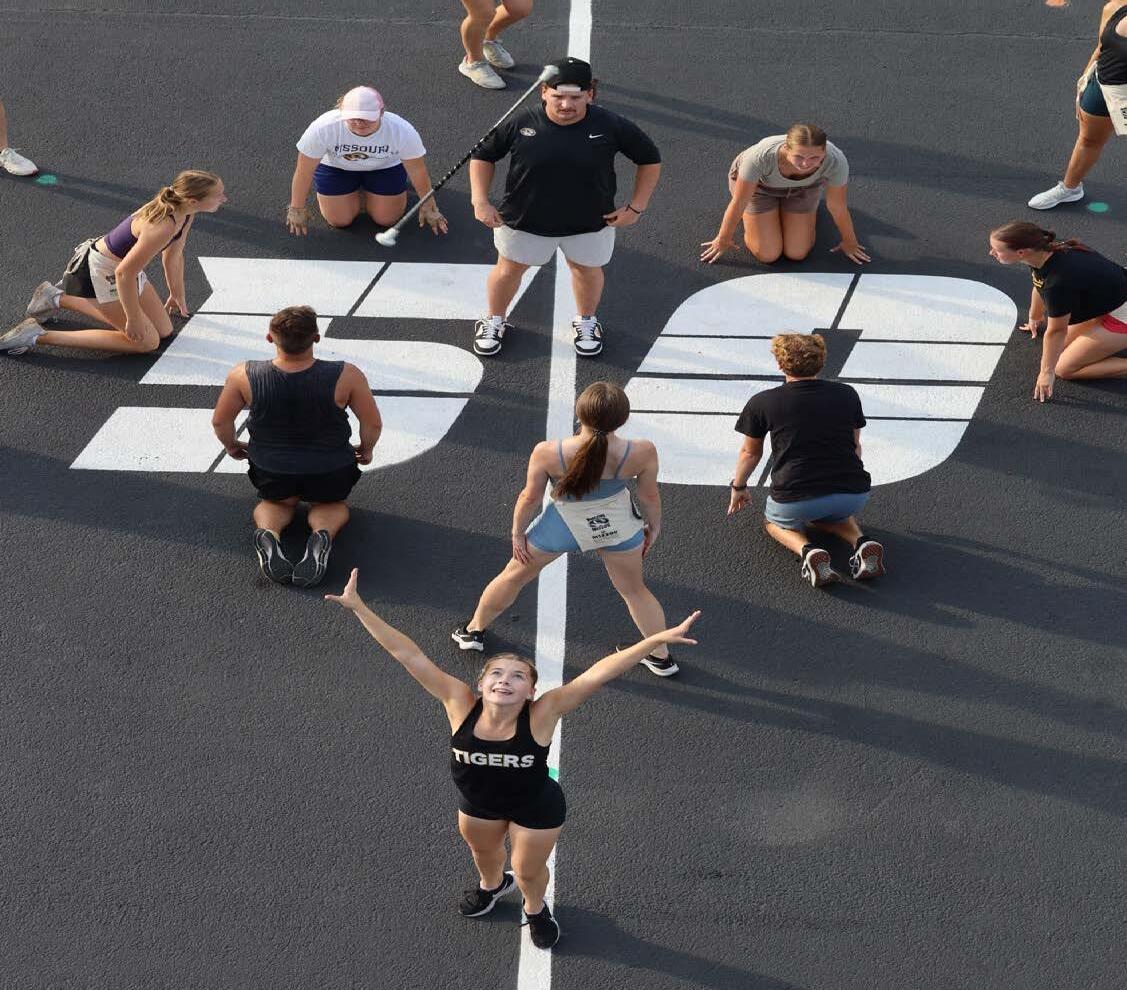
PHOTOGRAPHY BY ESMÉ ANGER
The soundtrack of the University of Missouri comes from Marching Mizzou’s Band 140. These 350 band members high-step, drum, twirl and, of course, march for up to eight hours a week to reach perfection. The band performs new songs each game, but Mizzou’s fight songs, ”Every True Son” and “Fight Tiger,” stay the same. You can hear these iconic anthems two weekends in a row on Nov. 8 and 15 against opponents Texas A&M and Mississippi State. Read the full story on page 5.

Save a life. Don’t D rive H oMe buzze D. BUZZED DRIVING IS DRUNK DRIVING.